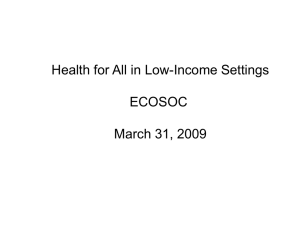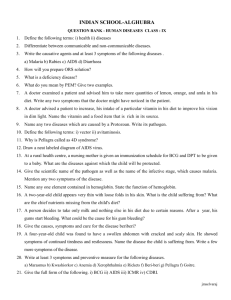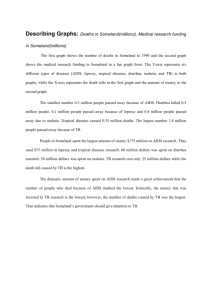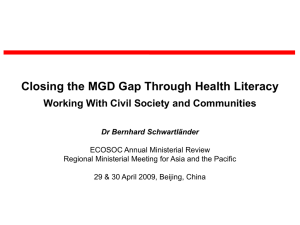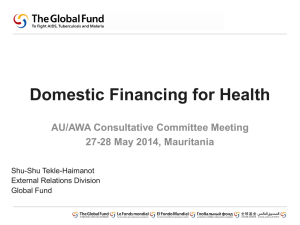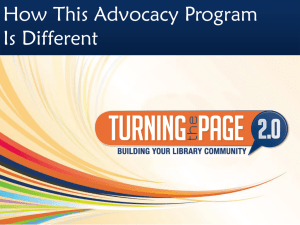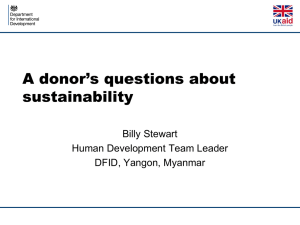Domestic financing presentation
advertisement
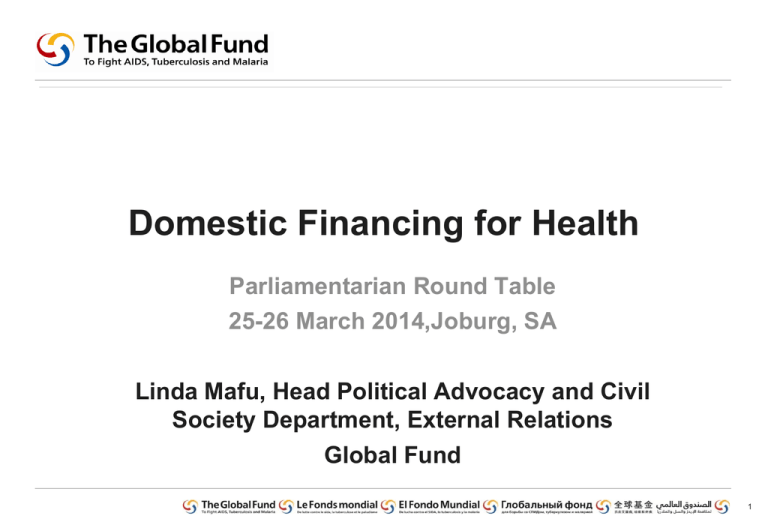
Domestic Financing for Health Parliamentarian Round Table 25-26 March 2014,Joburg, SA Linda Mafu, Head Political Advocacy and Civil Society Department, External Relations Global Fund 1 BACKGROUND Global Health Agenda • Unprecedented funding for health from 2002 to present for health and in particularly for AIDS, TB and Malaria through Global Fund • International Development Assistance is changing • New trends to watch for particularly in area of support for health • Major progress and achievements in improving peoples lives • Key MDG targets are on track to be achieved in number of African countries and need to protect and sustain progress 2 BACKGROUND Why invest in health? • Economic, social and political benefits from having a healthy nations ; citizens have the potential to be more productive and it can lead to demographic dividend • According to the Lancet Commission: “Reductions in mortality account for about 11% of recent economic growth in low and middle-income countries as measured in their national income account” • Governments have an obligation to provide health care- 3 Key Challenges • Value for Money: major improvements are needed in health programme efficiency and effectiveness • Domestic Advocacy: a large part of any increase in public funding for health will need to come from government, therefore need to develop a convincing business and advocacy case for increased public commitment in programs of proven effectiveness • Sustainability: Domestic public spending is set to continue as economic growth continues, however it will not be sufficient to address all the health needs. Therefore still a need for external resources in the short to medium term. Hence the need to explore innovative domestic financing mechanisms 4 What is needed for ATM 2014-2016 Estimated funding required $87 billion Mind the gap: 2.8 billion out of 15 billion just for 2014-2016. 5 Global Priorities Changing: Post 2015 MDG High Level Panel Report 6 Africa has made commitments • Abuja Declaration on HIV/AIDS, Tuberculosis and Other Related Infectious Diseases, 2001: Heads of State commit to spend at least 15 % of budgets on Health • Addis Ababa, African Union roadmap on shared responsibility and global solidarity for AIDS, TB and malaria response, 2012 Endorsed Roadmap on Shared Responsibility and Global Solidarity for HIV, TB and Malaria, Pharmaceutical Manufacturing Plan • Tunis Declaration on value for money, sustainability and accountability in the health sector, 2012 Enhance value for money, increase accountability improve sustainability of health resources 7 Domestic Investment 2011: % of total government expenditure Rwanda Malawi Zambia Togo Tanzania South Africa Botswana Nigeria Kenya Source: 23.7% 18.5% 16.0% 15.4% 11.1% 10.0% 8.7% 7.5% 5.9% UNAIDS, Oxford Policy Management, Et al. 8 How to sustain an ATM and HSS Response? 1. Increase donor support: getting more from existing donors or involving new donors 2. Increase domestic financing • • Public or government Private sector 3. Decrease the cost of the current response by improving efficiencies in existing programs But prevent new infections! 9 Criteria for Investment in Health and ATM • Level of national income, GDP or GNI. An approximation of resources available within a country • Degree to which the Government is able to raise revenue through taxes, levies, domestic borrowing, or other means. • Proportion of Government budget devoted to debt • Pre-existing pattern of disbursement to different sectors. For health if historical allocations have been low, infrastructure may be poor reducing the short-run capacity to absorb rapid increases and convert to service delivery. 10 Plan for analyzing “Fiscal Space” Macroeconomic analysis • Evaluating potential resource needs and resource availability, identifying future resource gaps and potential ways of eliminating such financial gaps. Microeconomic analysis- for eg. • Assessing potential opportunities to make the 3 largest interventions efficient: – ART – PMTCT – OVC 11 Areas where we are working on with countries and partners • Need for better data to better under which organization is spending what. This is true of both domestic and international funding-data needs to be improved and accessible • Political leadership is critical, and we have been working are developing advocacy messages to ensure that health continues to be a priority • Revisit the economic arguments for health, including the macro-economic ones • Address rigid budgeting practices making it hard to reallocate revenues toward health • Empower Health officials to talk to finance and finance to understand health 12 Areas where we are working on with countries and partners • Recognize and improve the role of civil society • Address the core question: it is possible to define the “right” mix of domestic and international investment in any country-will vary country by country. • Establish on a country by country basis an acceptable “benchmark” for countries to invest from their own resources. 13 Conclusion • No single blueprint for a country’s domestic funding • Health expenditure should keep pace with economic growth • Need to learn from each other and share best practices 14 Thank you. 15


